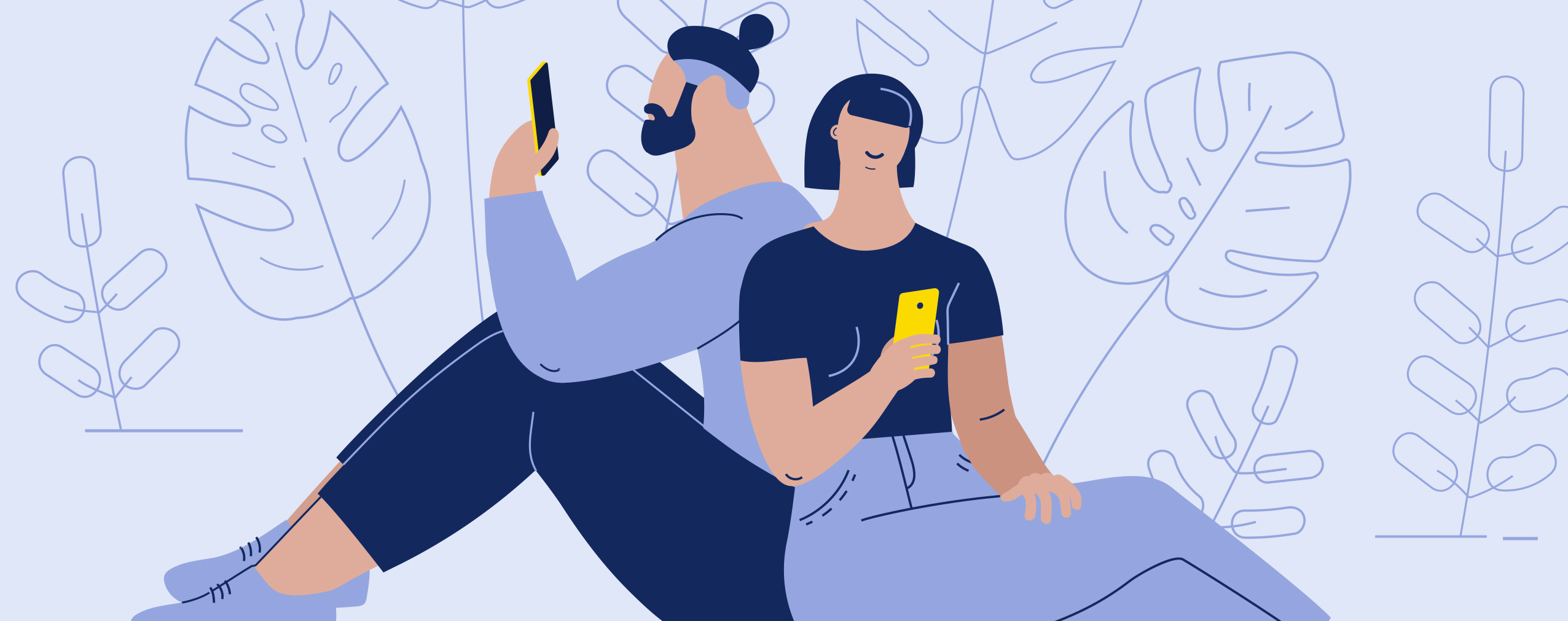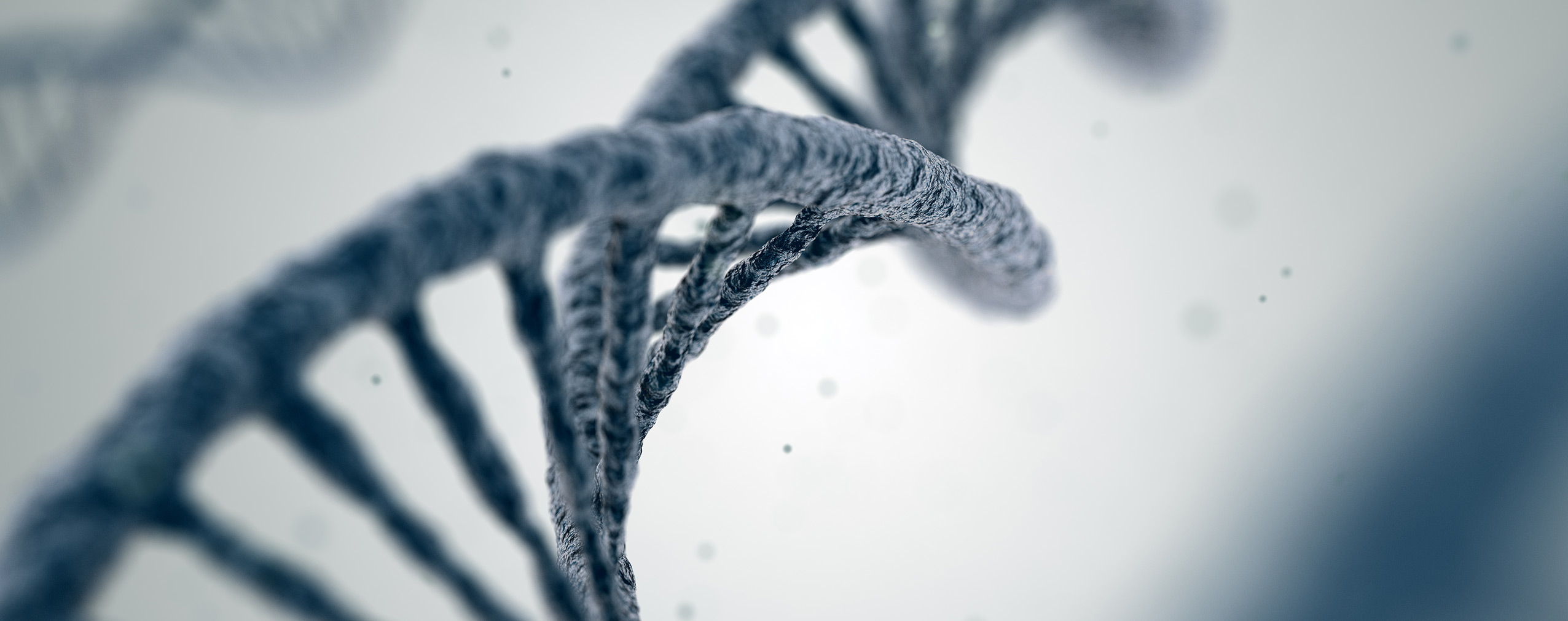The Internet opens up almost unlimited marketing and sales opportunities. To effectively reach customers, you need to use the right tools and data acquisition strategies. Lead generation can be much easier with webinars. In this article, you’ll learn what lead generation is, why you need lead generation and, most importantly, how to generate sales leads by hosting online events!
Lead generation has been a major concern for many marketing and sales professionals. Increasing competition and audience expectations make methods that worked well some time ago no longer effective. At the same time, a few basic principles remain relevant. Content marketing, video formats, and the ability to establish a direct relationship with a potential customer still allow you to achieve great results. Is there a format that combines these three elements? Of course, it’s webinars! How do you generate leads with them? Using the right tools it does not have to be difficult or expensive.
Table of Contents
What is lead generation?
Let’s start by explaining what lead generation is and why your business needs leads.
Lead generation is nothing more than the process of collecting leads (also often referred to as lead acquisition). What is a lead? It is your potential customer, meaning a company or an individual who may be interested in your product or service. How can this interest manifest itself? In digital marketing terms, it is usually the same as providing contact information. If you are able to obtain this information, you can precisely target potential customers with further messages or offers.
In most cases, the lead generation process is then based on a combination of two factors:
- The willingness of the potential customer to share their contact information,
- A registration form that will allow you to acquire sales leads.
In the process of lead generation, different skills are therefore important. On the one hand, the marketing skills will prove essential in convincing potential customers to establish a relationship with the company. At the same time, technological and even legal knowledge will also be necessary: generating leads is somewhat of a challenge in the context of regulations regarding the processing of personal data. But don’t worry, acquiring new customers doesn’t have to be difficult – you just have to use the right tools.
Types of leads
The very definition of a lead is simple. It is just a potential customer interested in your offer. Of course, leads can differ significantly, exactly in the same way as visitors to a stationary store vary. Some of them are ready to make a purchase right now, the vast majority – which is especially true in the virtual space – are just getting acquainted with the offers of particular companies and want to learn more about them. A marketer should be aware of this and, above all, learn what lead qualification is and what types of leads can be distinguished.
A marketing lead, or marketing qualified lead, is a customer who has become interested in an offer but is not yet ready to make a purchase decision. Very often this category includes potential customers who have decided only to leave their contact details, as well as those who have shown a wider interest, e.g. by visiting a website, browsing blog posts, or participating in events organized by the company. A marketing lead needs proper ” nutrition” in order to turn into a sales lead.
A sales lead, or sales qualified lead, is distinguished from a marketing lead by its readiness to make a purchase decision. Further “warming up” is no longer necessary. Instead, it is advisable for sales professionals to deal with the potential customer as quickly as possible.
Sales leads and marketing leads are therefore of a slightly different nature, and a big problem is their proper classification. This process is facilitated by lead scoring, a system for evaluating leads using strictly defined parameters and metrics. Its implementation significantly facilitates work and allows to precisely reach leads at different stages of the process. Lead scoring can be automated as part of marketing automation activities.
Leads can be divided in several other ways, e.g., depending on the target group:
- B2B leads represent potentially interested businesses.
- B2C leads correspond to potentially interested consumers.
You may also encounter other types of leads, depending, for example, on the source of their acquisition. In the case of SaaS products, a product qualified lead is very popular, in which the interest is the result of the opportunity to use the trial period of the tool or its demo version. Another type of lead is a service qualified lead: in this case, customer service employees are responsible for the positive completion of the sales process (e.g. assuming upselling).
Leads and your sales pipeline
It is easy to see that the nature of leads reflects the successive stages of the sales funnel. This is perfectly illustrated by the lead funnel graphic prepared by leadsquared, which additionally indicates the activities undertaken by the marketing department and the sales department:
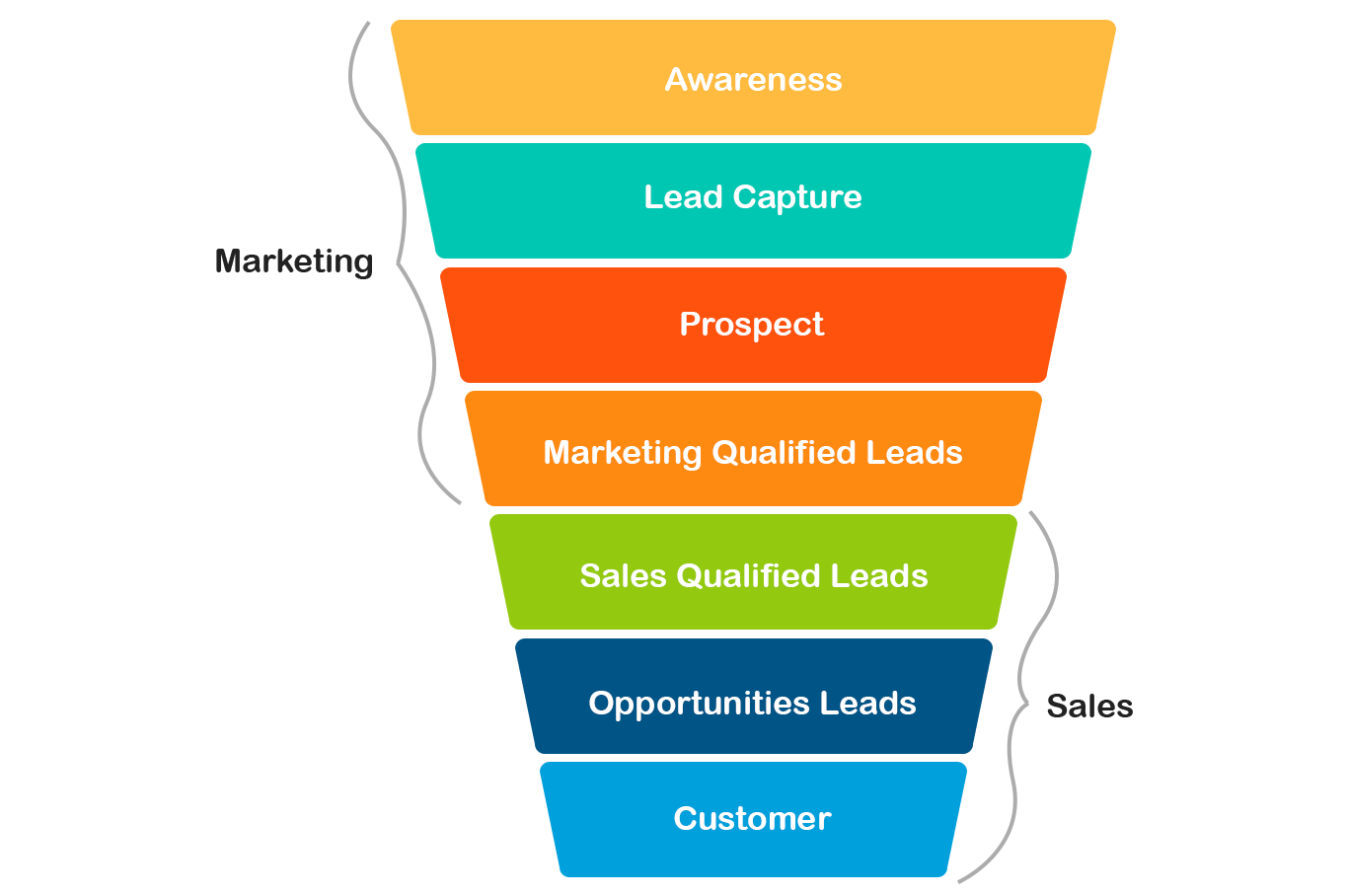
The process of generating sales leads in most cases will require a lot of additional effort. As you can see, marketing activities start even before the direct lead acquisition: first it is necessary to develop brand recognition, inspire trust and establish first contact. This is a major challenge especially in the context of the growing awareness of sharing personal information.
A common problem is the low value of leads. In this respect, leads can be divided into three categories:
-
Cold leads (also called “long leads”) are contact details of people who have not shown interest in your offer. Of course, this situation may change in the future (also due to your marketing efforts). Typically, the vast majority of leads acquired are long leads.
-
Warm leads are simply marketing leads. A potential customer still needs some time and thought, but shows interest in your offer and interacts with you, e.g. by responding to your marketing content, reading your blog, or attending your events.
-
Hot leads, also referred to as short leads, is another name for sales leads. This group includes the most valuable leads that are likely to make it to sales.
The process of generating leads starts a cycle that doesn’t end when a customer is acquired. A group of paying customers should also be targeted by marketing efforts to build a strong relationship and drive further sales.
Lead magnet: your way to generate leads
It’s time to move on to practice. Acquiring sales leads is not easy. The market is booming, internet users are bombarded with marketing messages, and they’re not too keen on sharing their data. According to our survey, more than 90% of online meeting attendees pay attention to their online privacy, and 88% at least try to familiarize themselves with accepted terms of use and consents. When asking potential customers for their contact information, you need to simultaneously act legally and convince your audience to share it voluntarily.
How do you effectively reach out to potential customers and ensure lead generation? You need something that will interest the audience and make them consciously share their data. That something is a lead magnet, a magnet that attracts your leads.
Lead generation is a kind of barter: by offering something in exchange for customers’ data, you increase the chances of success. What can serve as a lead magnet?
- An e-book
- webinar
- industry report (by the way – you can download our State of Online Events report for free and without leaving your contact information!)
- free consultations
- access to premium content
- promotional offer
- free version of the tool, trial.
Of course, a lot depends on the sector you operate in and the standards of the industry. However, there are a few proven, universal ways to create content that supports lead generation.
Webinars in lead generation: why you should use them?
Content marketing is still king. However, as time goes by, the most preferred formats are changing. Currently video content is the most popular. At the same time, direct contact with experts is even more appreciated. This is why webinars are an ideal way to generate sales leads. Potential customers are more likely to sign up for a webinar if you ensure that it is well covered and promoted. The marketer responsible for hosting the event gains a lot of time and saves resources. How does this happen?
Generating sales leads requires a combination of marketing and technology. As such, it usually means using several different tools. This, in turn, makes the cost of acquiring a lead increase along with your team’s effort.
Imagine using an e-book guide as a lead magnet. Apart from marketing activities, you need to prepare an attractive e-book, a website (e.g. landing page) with a form allowing to leave contact details and a solution for the user to download the file.
What if it was possible to reduce all this to a single tool and automate the entire process? See how it looks like in the case of a webinar.
How to generate leads with webinars? Step by step lead generation strategy
How to simplify sales lead generation with webinars? Let’s walk through the process step by step using ClickMeeting:
-
The idea is crucial. Of course, for a lead magnet to work and be useful in generating leads, it has to be attractive from the perspective of your potential customers. So think about the topic of the webinar, its format, the appropriate speaker (maybe it’s a good idea to invite a recognized expert in your branch?), but also consider the time and duration of the event. You can find some proven suggestions in our report.
-
Choose the type of event. It’s time to move on to your webinar and online meeting platform. The first step is to set up your webinar. ClickMeeting offers three types of webinars: a live webinar, where you can meet face-to-face with participants; an automated webinar, based on a recording you’ve made and enhanced with additional features; and an on-demand webinar, allowing your audience to access your content anytime they want. Each of them will prove useful in lead generation. What’s more, you’ll be able to use the live webinar recording later, for example by placing it as part of an on-demand webinar, or embedding it on your website or blog.
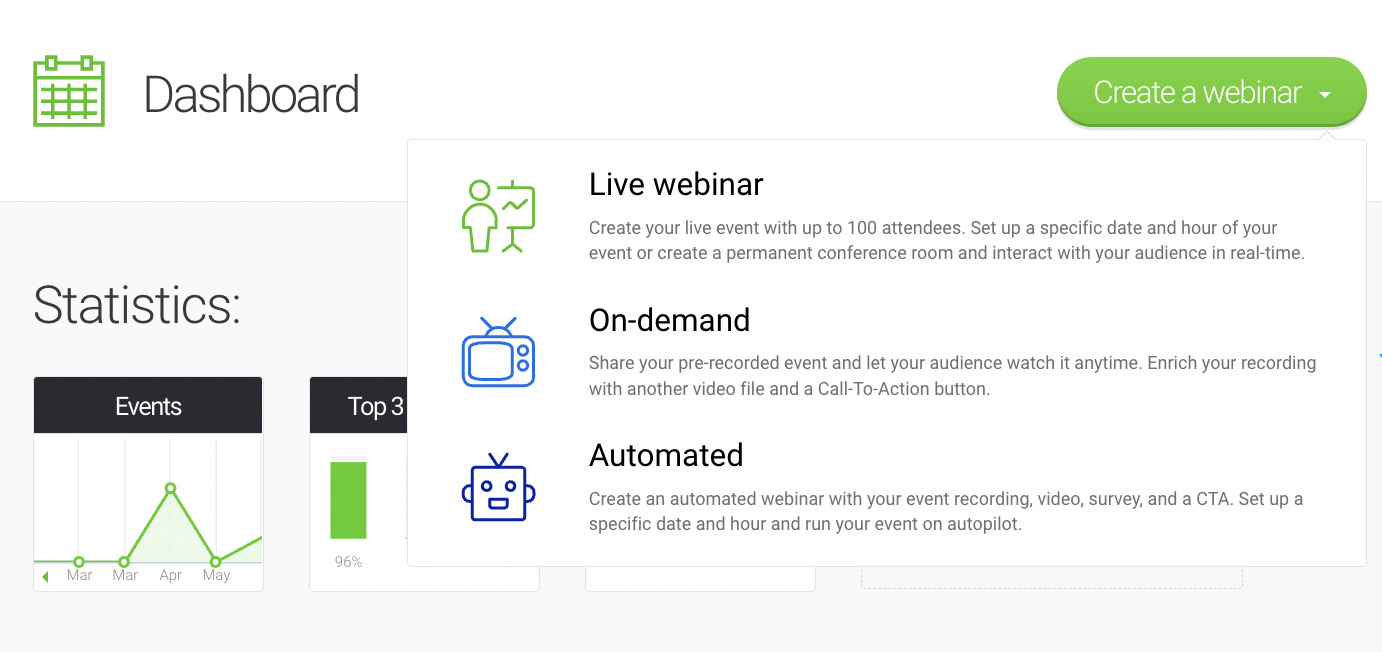
-
Create an event. Let’s say you run an accounting firm and you’re eager to attract new clients. So it would be a good idea to organize a webinar on, for example, the latest tax changes. Surely many entrepreneurs will be willing to participate in such an event, and you will gain not only their contact information, but also a space to present your expertise and your company’s offer.
Determine the name of the room, its URL, the date of the event, and the type of access. You can also create a paid webinar, but this type of format doesn’t always work for lead generation.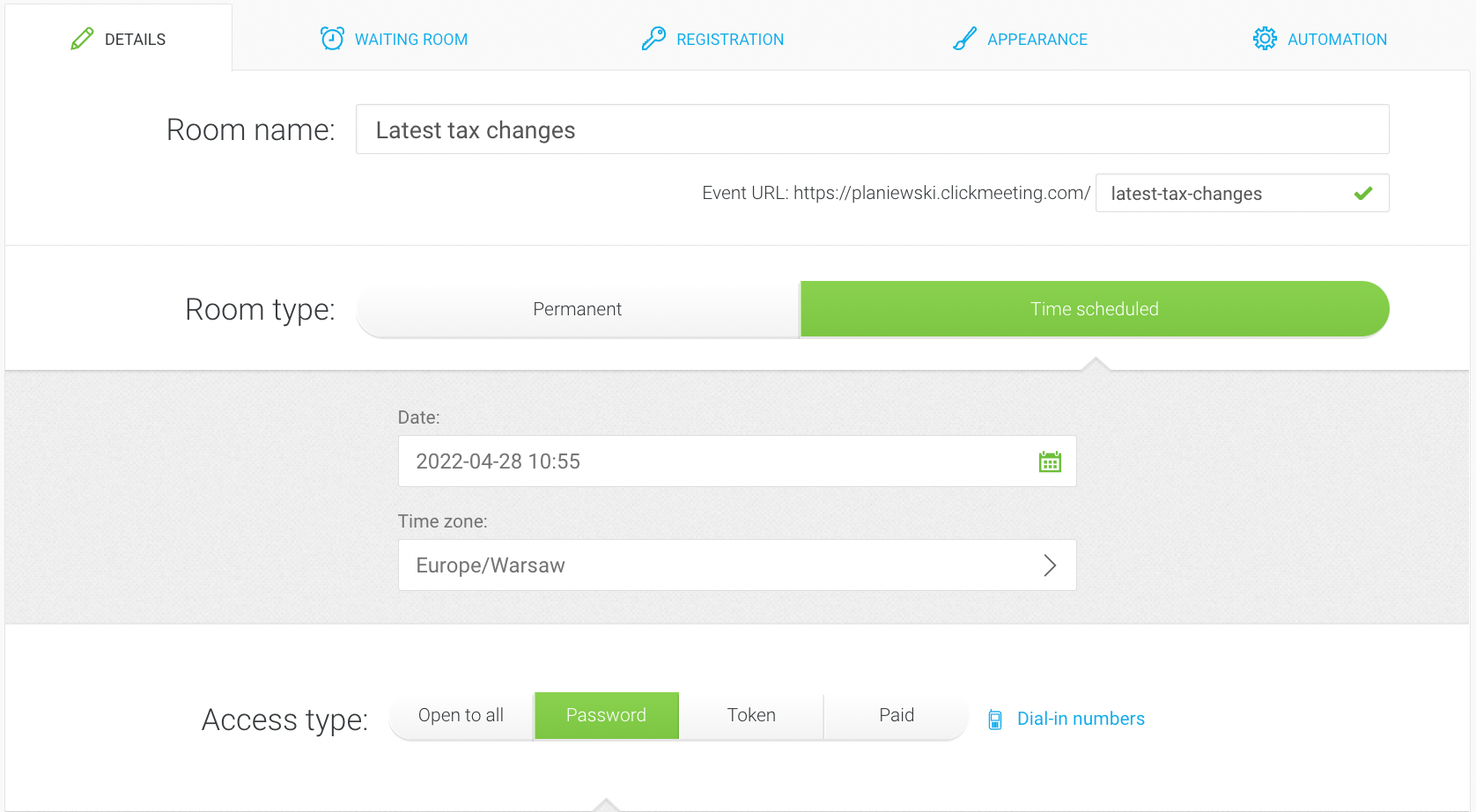
-
Set up your registration page. It’s time for the key issue in lead generation: configuring the form that allows people to submit their personal information. This is often a major problem if you create landing pages yourself. If you decide to organize webinars with ClickMeeting, you will do it in a few moments without involving other tools.Simply choose the scope of data that is necessary to achieve your goal. Keep regulations in mind. By adding checkboxes to your sign-up page, you’ll allow recipients to give you their consent. Consider which ones will be mandatory and which ones will be voluntary. However, don’t forget to prepare event regulations or another document informing your participants about their rights, and how their personal data will be processed.
 5.
5.Personalize the event room and other pages. As a final step, make sure your design is professional. With ClickMeeting, it’s easy to customize your webinar room, login page, registration page, waiting room, profile page, and more – plus you can upload your own content to make it even more engaging.
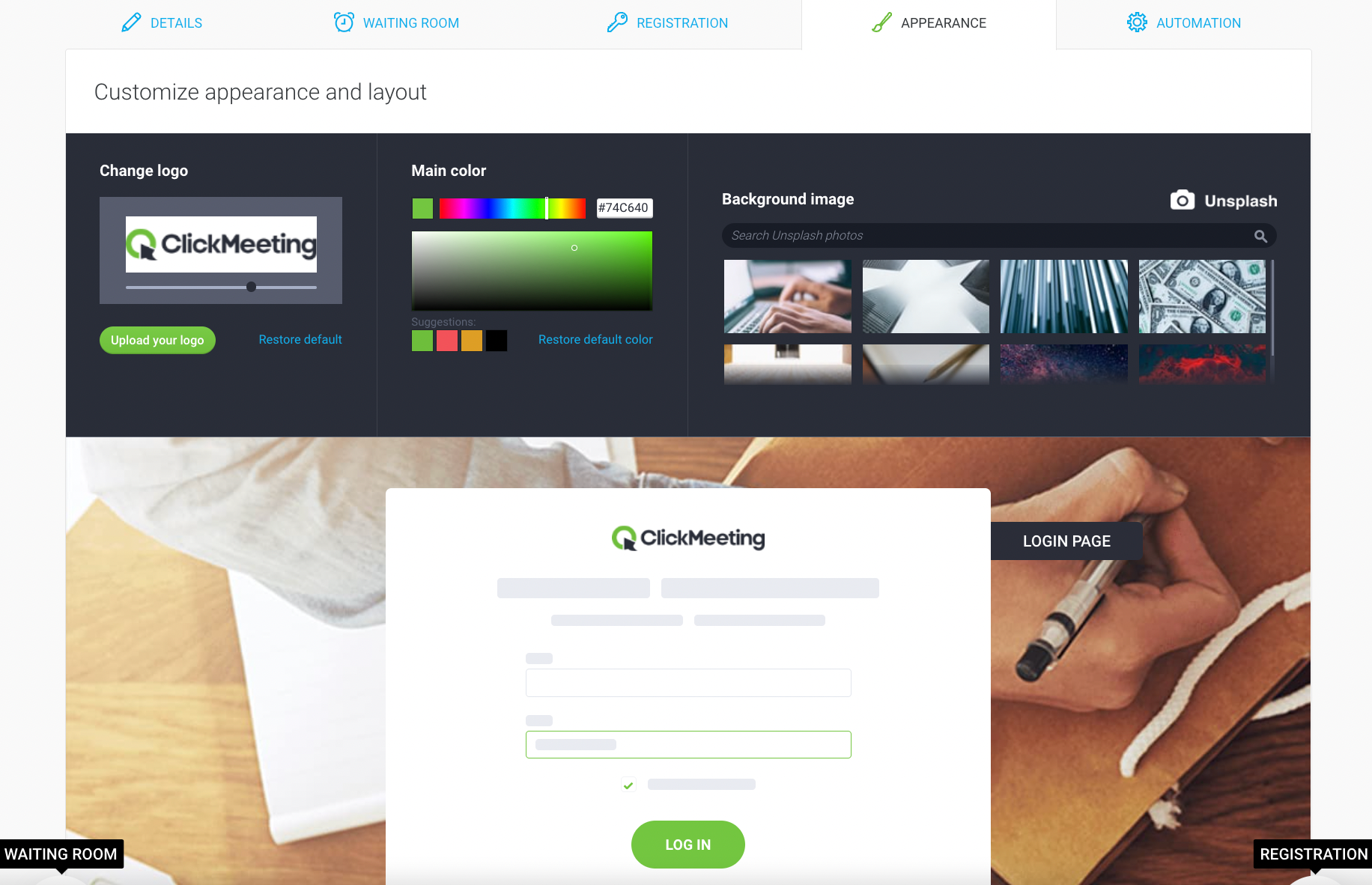 6.
6.Create an event and invite your potential customers! Of course, in order to acquire leads you need to reach your audience effectively. For this purpose, you can use standard digital marketing tools. Don’t forget about social media promotion and content marketing. You can also use your ClickMeeting profile page as a landing page and automate the process of sending reminder and thank you emails.
As you can see, acquiring leads can definitely be simpler. But enough theory, see it in practice! Start your free 14-day ClickMeeting trial and test all the platform’s features. No credit card information required!
Test ClickMeeting for free
Webinar automation: even more efficient lead generation
Effective lead generation is directly connected to your marketing automation efforts. With the right webinar platform, you can also automate many processes related to your events. This will allow you to make better use of the opportunities offered by content marketing, reach a larger audience and generate leads more efficiently.
You can find automation settings in a separate tab:
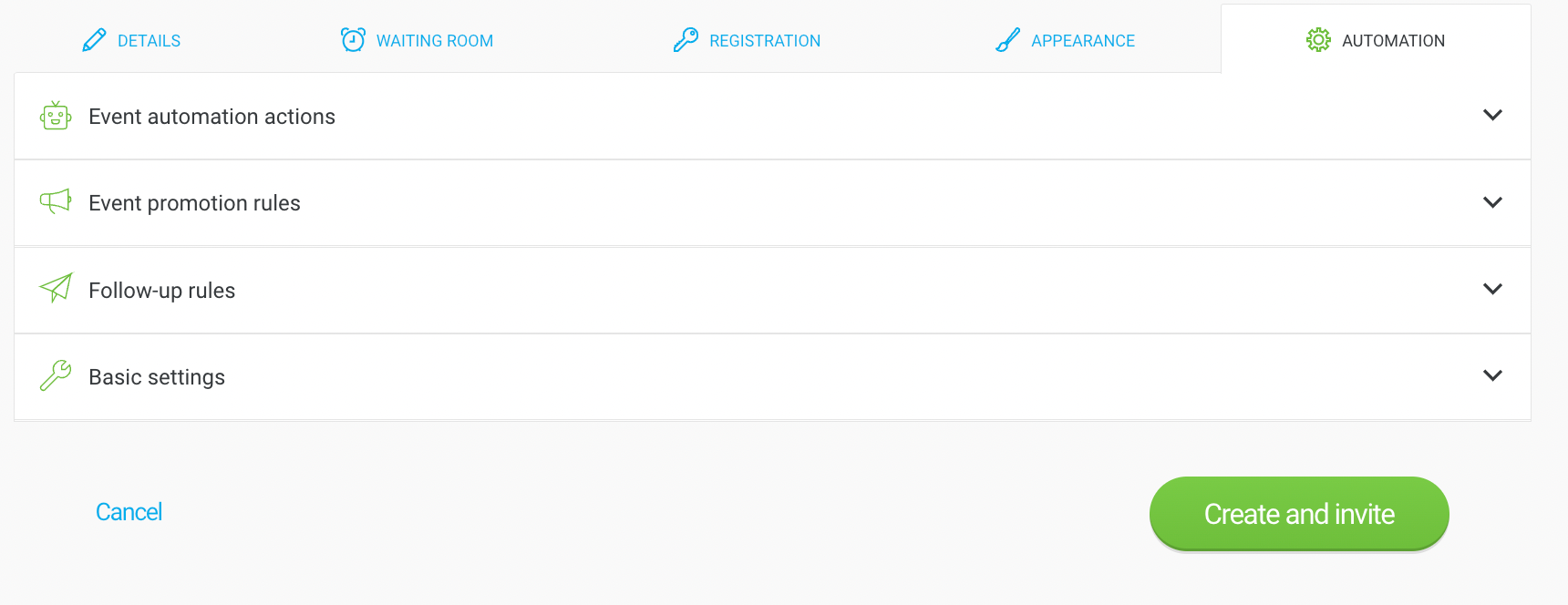
In the event automation section you will set, among other things, an automatic event stream on Facebook or YouTube, which will help you reach a larger audience. You can also decide whether you want to automatically start recording the event, so that you can create material useful in your content marketing activities or when creating an automated webinar. Already at this stage, you will also set the publication of the recording on your YouTube channel.
Communication with your audience: your customer acquisition strategy must be based on keeping in touch with your customers. This is also an important aspect of lead generation. Even before creating an event, you will be able to automate event reminders and define follow-up actions. After the webinar you can, among other things, redirect participants to your own website and automatically send a thank-you message. This can include a recording of the webinar, a certificate of attendance, a link to your profile page and a request to share feedback. You can also send a follow-up message to people who registered for the event but did not attend. In the same place, you can invite event attendees to your next webinars.
How much does it cost to generate leads?
The cost of acquiring leads depends on many factors. It largely depends on the target audience, the communication channels and tools used. The cost of preparing the “magnet” is also important. In this respect, you can save a lot of money by using webinars – you won’t even need additional equipment to start your adventure with this format. All you need is a microphone integrated with headphones and a webcam in your laptop.
When calculating the cost of acquiring a lead, however, you should take into account all the expenses incurred in the process – both those related to the production of the material and its promotion. The CPL, or Cost per Lead, is determined by dividing them by the number of leads acquired. Of course, to gain the best possible overview, you should calculate it independently for each acquisition channel or campaign.
For example:
You invite a well-known tax law expert within your target audience to your “Latest Tax Changes” webinar. You pay him 1000 USD for hosting the event. To promote the webinar you use social media: you spend 500 USD on sponsored posts and the same money on advertising in other channels (to keep things simple we don’t include fixed expenses such as salaries of your employees or subscriptions to necessary tools).
Finally, as a result of the webinar, you manage to acquire 100 leads. What is the cost of acquiring a lead? In this case, the CPL is the result of 2000/100 action, so it is 20 USD.
Of course, apart from the cost of acquiring sales leads you will also be interested in the cost of acquiring new customers, or CAC (Customer Acquisition Cost). In this case you have to consider much more extensive expenses – apart from the cost of acquiring sales leads you have to take into account other marketing and sales activities related to acquiring customers, including the costs of running campaigns, used tools, delegating tasks or maintaining teams.
It’s certainly not possible to analyze expenses without automation. ClickMeeting can be easily integrated with the Zapier platform, enabling you to effectively manage your marketing strategy.
Lead generation vs. lead nurturing
Generating leads is not everything. As you can see, very often they also need to be “warmed up”, i.e. led through the successive stages of the sales funnel until a purchase decision is made. This process is referred to as lead nurturing.
The actions taken depend, of course, on the nature of the lead and on the stage of the sales pipeline. Too aggressive communication, focused on rapid sales in the first phase, when the lead is not yet accompanied by a purchase decision or is not interested in the offer at all, will frighten off the potential customer and may even distract him from the brand. On the other hand, too conservative actions in the case of sales leads may hinder conversion. The suggested activities and formats are presented in the graphic prepared by the Klientboost agency:

Webinars are ideal for both lead generation and lead nurturing activities. Think of lead generation as the beginning point of not just a process, but a full cycle that includes aftercare. Webinars can be used successfully at any stage of the funnel.
At the very beginning you will ensure brand awareness and get potential customers interested in your product or service. Your events should have an expert character and be valuable from the perspective of someone who is interested in similar issues, but not yet motivated to make a purchase decision. By creating a webinar, you will already succeed in acquiring a marketing lead at this stage.
Customer acquisition is often a lengthy process – so you may find that your lead would like to attend several events, explore your websites, blog and read reviews about your company. Take advantage of the opportunities offered by content marketing and social media marketing, create compelling content, and you’ll certainly be able to “warm up” your leads. Of course, you will also need lead scoring here, so you can assess their quality.
As your leads nourish, you can also change the nature of your content. Once you’ve gotten to know your potential customers and established a deeper relationship with them, it’s a good idea to invite them to a product demo, where you can show them exactly how your product works. Don’t forget about interaction and direct contact.
When a marketing lead turns into a sales lead, it is time to involve the sales department. Again, webinars will work well here. According to our report, as many as 16% of the events held on the ClickMeeting platform in 2021 were sales-related. During a webinar, you can use a CTA button that will take your audience to your landing page with a price list. And during the Q&A session, you’ll answer any questions they ask.
Done! As you can see, the marketing team and the sales team can use webinars equally effectively, and skillfully prepared online events will fill the entire sales funnel.
Time to get to work! Try ClickMeeting for free now and see how webinars can help you generate leads!
Try ClickMeeting for Free!
Lead generation methods
What is effective lead generation? Lead generation and marketing strategy are important issues. They are inseparable elements of the success of any business, so it is worth learning about the various lead generation methods tailored to the specifics of the industry and target group. Modern lead generation methods include both organic activities and paid campaigns as part of performance marketing. Google Ads and Facebook Ads are the foundation of paid acquisition, allowing for precise targeting and quick acquisition of contact details of companies interested in the offer. Lead generation and conversion are closely related – choosing the right lead generation tool directly affects conversion rates and the quality of the contacts acquired. Effective methods also include event marketing, which builds relationships and naturally generates high-quality leads through webinars and industry events. Lead generation and other forms of marketing, such as SEO, allow for long-term lead stream building through visibility in search results. We must not forget about more direct methods, such as telemarketing or cold mailing, which, despite controversy, still bring results in certain industries, especially when conducted professionally and with respect for the audience. The key to success is the integration of various methods and continuous optimization of activities based on the analysis of the effectiveness of individual lead generation channels.
Lead generation and lead quality
Lead generation campaigns obviously have a clear task: to use lead generation channels to acquire the highest quality contacts. The relationship between lead generation and lead quality therefore determines the effectiveness of marketing activities and return on investment. Not every lead acquired has the same value for the business – differences in lead quality can be drastic, ranging from completely uninterested contacts to people ready to buy immediately. The quality of leads depends primarily on the precision of targeting, the attractiveness of the lead magnet offered, and the alignment of communication with the actual needs of the target group. In the lead generation process, it is crucial to find a balance between quantity and quality – it is better to acquire 50 high-quality leads with a 30% conversion rate than 500 low-quality leads with a conversion rate of less than 1%. The source of leads also affects their quality – webinars and industry events usually attract a more engaged audience than mass display campaigns. Lead scoring, a system of evaluating leads on a point basis, allows you to objectively measure their quality based on demographic and behavioral criteria and the degree of engagement. High-quality leads translate directly into lower customer acquisition costs (CAC), shorter sales cycles, and higher customer lifetime value (CLV). Therefore, in your lead generation strategy, it is worth focusing on attracting the right people through valuable content, precise qualification forms, and continuous process optimization based on conversion analysis at every stage of the sales funnel.
How to ensure quality?
- Choose the right lead generation channels.
- Optimize the lead acquisition process.
- Invest in an effective lead generation tool.
With these three elements, your lead generation efforts will bring great results.
FAQ – Frequently asked questions about lead generation
Definition of lead generation
Lead generation is a comprehensive marketing process that involves generating interest in a product or service in order to obtain the contact details of potential customers. It is the foundation of modern digital marketing, encompassing all activities that lead to the identification and attraction of individuals or companies that may become future customers.
In practice, lead generation is an exchange of value – a company offers something valuable (knowledge, a tool, a discount) in exchange for the recipient’s contact details, such as their email address, phone number, or company name. However, this process goes beyond simply collecting contacts – it also includes preliminary qualification of potential customers, segmentation according to their level of interest, and forwarding them to the appropriate departments within the company.
Effective lead generation requires a combination of three key elements: an attractive value proposition (lead magnet) that will encourage recipients to leave their details, efficient technological tools for collecting and managing contacts, and a well-thought-out communication strategy that will transform raw data into real business opportunities.
In the digital age, lead generation has become an essential part of any business development strategy, replacing traditional, less effective methods of customer acquisition. It allows for precise measurement of the effectiveness of marketing activities, optimization of acquisition costs, and building lasting relationships with customers from the very first contact. It is not only a way to acquire contacts, but above all a method of building a predictable and scalable sales process that ensures a steady flow of potential customers to the company.
What is a Marketing Qualified Lead (MQL)?
A Marketing Qualified Lead is a potential customer who has shown interest in the company’s offer but is not yet ready to buy. An MQL requires further marketing activities, such as education through content marketing or participation in webinars, to convert into a sales lead.
What is a Sales Qualified Lead (SQL)?
A Sales Qualified Lead is a lead that is ready to make a purchase decision. An SQL has already gone through the education and “warming up” phase, so it should be passed on to the sales department as soon as possible to finalize the transaction.
What is effective lead generation?
Effective lead generation is based on offering valuable content (lead magnets) in exchange for contact details, using the right technological tools, and conducting activities in accordance with personal data protection regulations. It is also crucial to tailor communication to the stage of the sales funnel.
Lead generation and lead quality – what is the connection?
Lead quality depends on precise targeting, the attractiveness of the lead magnet, and the qualification process (lead scoring). High-quality leads are those that show genuine interest in the offer and have the potential to convert into customers.
What is lead management?
Lead management is a comprehensive process of managing leads, including their acquisition, qualification (scoring), nurturing, and transfer to the sales department. It also includes analyzing the effectiveness of activities and optimizing the conversion process.
How does a lead generation form work?
A lead generation form collects contact details of potential customers in exchange for access to valuable content. It contains fields for basic information (name, email, company) and marketing consent checkboxes in accordance with GDPR requirements.
What is lead generation?
Lead generation is the process of obtaining contact details of potential customers through various marketing channels – forms on websites, webinar registrations, e-book downloads, or product trials.
What tools support sales lead acquisition?
The main tools include: webinar platforms (e.g., ClickMeeting), CRM systems, marketing automation tools, landing page builders, contact forms, email marketing systems, and lead analysis and scoring tools.
What is the definition of lead generation?
Lead generation is a marketing process that involves generating interest in a product or service in order to obtain the contact details of potential customers. It includes all activities that lead to the collection of information enabling further communication with prospects.
The most important lead generation channels
The key channels are: webinars and online events, content marketing (blogs, e-books), social media, SEO and SEM, email marketing, landing pages, and referral programs. The choice of channel depends on the target group and industry.
Lead generation and marketing strategy – how do they connect?
Lead generation is the foundation of a marketing strategy, defining how to acquire potential customers. It must be integrated with business goals, the marketing budget, and other promotional activities of the company.
The best lead generation tool
There is no one-size-fits-all tool – the choice depends on the industry and target group. Webinar platforms such as ClickMeeting are ideal thanks to their combination of registration forms, communication automation, and the ability to present valuable content.
Do webinars support online lead generation?
Yes, webinars are one of the most effective lead generation tools. They combine valuable content, interaction with experts, and the natural exchange of contact details during registration. In addition, they build credibility and relationships with potential customers.
What are effective lead generation activities?
Effective activities include: creating valuable lead magnets (webinars, e-books), optimizing registration forms, personalizing communication, lead nurturing through email marketing, using social proof, and systematic analysis and optimization of processes.
The best methods for acquiring leads
The best methods include: organizing educational webinars, offering free trials, creating calculators and online tools, publishing case studies, running referral programs, and using retargeting.
What does the lead generation process look like with webinars?
The process includes: choosing a webinar topic, creating an event on a webinar platform, configuring a registration form, promoting the event, conducting the webinar, automatic follow-up actions, and transferring leads for further nurturing or sales.
Do webinars generate valuable leads?
Yes, webinars generate high-quality leads because they attract people who are genuinely interested in the topic. Attendees consciously devote their time, which indicates a higher level of engagement than, for example, downloading an e-book.
How to generate marketing leads with webinars?
Organize educational webinars focused on the problems of the target group, promote them in the right channels, use registration forms to collect data, offer recordings as lead magnets, and automate communication before and after the event.
What is a satisfactory number of leads?
There is no universal number—it depends on the industry, company size, and business goals. More important than quantity is the quality of leads and the conversion rate. It is better to acquire 10 high-quality leads than 100 who are not ready to buy.
Can a lead generation strategy be based on webinars?
Yes, webinars can be the main pillar of a lead generation strategy, especially in B2B industries and services that require customer education. However, they should be supplemented with other marketing activities to maximize results.
Lead generation and GDPR – what to look out for?
It is essential to obtain informed consent for data processing, clearly communicate the purpose of data collection, ensure the possibility of withdrawing consent, store data securely, and respect the rights of data subjects.
Lead generation in B2B and B2C marketing – what are the differences?
In B2B, the sales cycle is longer and requires more touchpoints and education (webinars, white papers). In B2C, the process is faster, with emotions, social proof, and instant gratification playing a greater role. B2B focuses on ROI and business value, while B2C focuses on personal benefits and lifestyle.
What is the lead generation form in ClickMeeting?
The lead generation form in ClickMeeting is an integrated tool for collecting contact details of webinar attendees, eliminating the need for external solutions. The system works automatically – when registering for a webinar, potential customers fill in customizable form fields, providing their details in exchange for access to the event. A key advantage is the full customization of the scope of information collected – you can specify which fields are mandatory (e.g., name, email) and which are optional (e.g., company name, position, phone number), adapting the form to the specifics of your industry and marketing goals. ClickMeeting also allows you to add GDPR-compliant marketing consent checkboxes, enabling legal data processing and further sales activities. The form is fully integrated with the event registration page, which can be visually customized by adding your company logo, brand colors, and your own content. After completing the form, the system automatically sends registration confirmation, event reminders, and follow-up messages, which significantly automates the lead generation process. The collected data is stored in the ClickMeeting panel, from where it can be easily exported to CRM or other marketing tools through integrations with platforms such as Zapier. In addition, the form collects conversion statistics, showing the effectiveness of the registration page and allowing for continuous optimization of the lead acquisition process through webinars.
What does the lead acquisition process in ClickMeeting look like step by step?
The lead acquisition process in ClickMeeting is intuitive and automated, allowing you to effectively generate contacts without involving multiple tools. Here is a detailed step-by-step guide:
Step 1: Planning and selecting a webinar topic Start by identifying an attractive topic that solves a specific problem for your target audience. Think about the format of the event (expert presentation, Q&A, product demo), select the right speaker, and determine the optimal date and duration of the webinar.
Step 2: Create an event in the ClickMeeting panel Log in to the platform and select the type of webinar – live (direct contact with attendees), automatic (playback of a recording at a set time), or on-demand (available to attendees at any time). Each format effectively supports lead generation.
Step 3: Configure basic settings Name the event, set a unique room URL, select the date and time, and specify the access type. For lead generation purposes, free events with mandatory registration work best.
Step 4: Customize the registration form This is a key part of the process—configure the form fields, specifying the scope of data to be collected (name, email, company, position, phone number). Decide which fields are mandatory and which are optional. Add GDPR-compliant marketing consent checkboxes, specifying which consents are required for registration.
Step 5: Customize the registration page and room Personalize the look of the registration page by adding your company logo, brand colors, and event description. Also, configure the look of the webinar room, login page, waiting room, and profile page to create a consistent experience for attendees.
Step 6: Setting up communication automation In the automation tab, configure automatic event reminders (one day before, one hour before), welcome messages, and follow-up communication. Set up automatic sending of recordings, participation certificates, or invitations to future webinars.
Step 7: Promote the event Use the generated registration page link in your marketing campaigns – share it on social media, send it in a newsletter, or post it on your website. ClickMeeting also allows automatic streaming to Facebook or YouTube to increase your reach.
Step 8: Conducting the webinar During the event, use features that engage attendees – polls, Q&A, chat. You can use a CTA button that directs to your offer and automatically record the event for later use.
Step 9: Post-webinar activities The system automatically sends thank-you messages, a recording of the event, and additional materials. People who registered but did not attend will receive a separate message with the option to view the recording.
Step 10: Export and analyze leads Export the collected data from the ClickMeeting panel to a spreadsheet or integrate it directly with your CRM via Zapier. Analyze event statistics—number of registrations, attendance, engagement—to optimize future webinars.
The entire process, from creating an event to collecting leads, can be carried out within a single platform, without the need to create separate landing pages or configure external forms, which significantly simplifies and speeds up lead generation through webinars.
How webinars support lead generation
Webinars are one of the most effective lead generation tools, combining valuable content, direct contact with experts, and the natural exchange of contact details. As a multifunctional tool, the webinar platform integrates various lead generation channels in one place – from the registration form, through automatic email marketing, to the possibility of streaming on social media. This allows you to generate marketing leads at every stage of the sales funnel, from building brand awareness to finalizing transactions.
Webinars support lead generation through a natural exchange of value – attendees are happy to leave their contact details in exchange for access to expert knowledge, which means that the leads obtained are of high quality and genuinely interested in the topic. Integration with email marketing allows for automatic lead nurturing through a sequence of messages before the event (reminders), during the event (additional materials), and after the event (recording, certificates, invitations to future webinars).
Importantly, webinars act as standalone lead generation channels, but also reinforce other marketing activities. Event recordings can be used as lead magnets on your website, in social media campaigns, or as premium content in email marketing. The ability to segment attendees based on their engagement during the webinar (questions asked, participation in surveys, attendance time) allows you to precisely generate marketing leads with varying degrees of purchase readiness.
The effectiveness of webinars as a lead generation tool also stems from building relationships and trust—the presentation of expert knowledge live, the opportunity to ask questions and interact makes the lead already “warmed up” and more inclined to take further action. In addition, process automation in webinar platforms eliminates manual work, allowing you to focus on creating valuable content that will attract the right target audience and effectively fill the sales pipeline with high-quality leads.



 (4 votes, average: 4.00 out of 5)
(4 votes, average: 4.00 out of 5)